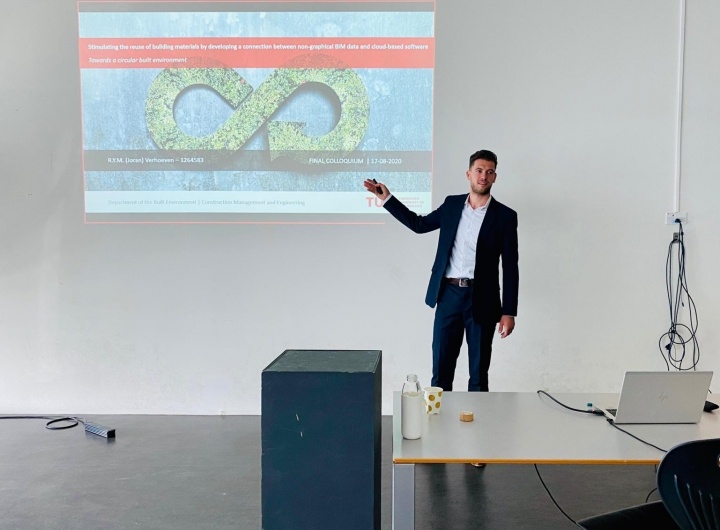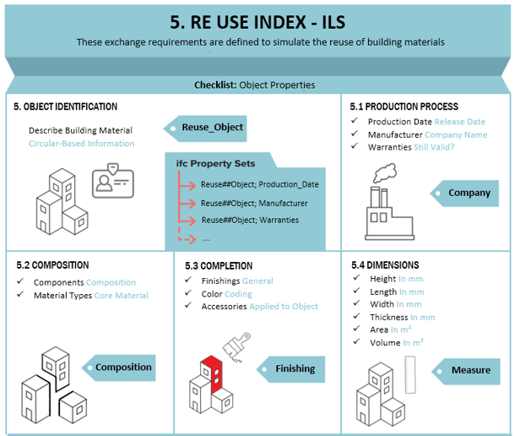The reuse of building materials in a circular construction sector

October 12, 2020 by Joran Verhoeven, Graduation Project
At the beginning of February, I started my graduation period in the program Construction Management & Engineering at the Eindhoven University of Technology. I did my graduate research in cooperation with BASED BIM Management & Consultancy. In this blog, I’ll look back on my research and what BASED has meant for me.
Reducing waste production in the construction sector
The goal of my research was to address waste production within the construction industry in the Netherlands. Why is this such a significant problem? The construction industry has a substantial share of total waste production within the Netherlands – almost 50 percent in 2017. It is abundantly clear this needs to change.
Over the years, the construction sector has started to adopt new methods to reduce waste production. In particular, the transition from a linear to a circular construction sector provided the most significant change. The use of recycled building materials and the recycling of waste production have led to a considerable reduction in the high numbers of waste produced. However, these recycling methods are still not the ideal starting point, and there are greater benefits to be achieved within the direct reuse of building materials. For example, reproduction is no longer necessary, which reduces CO2 emissions, energy and water consumption. It can also save costs, as the building materials do not have to be disposed of, and their sale can actually generate a profit.
Stimulate reuse through BIM data and cloud-based software
The challenge is how to ensure the reuse of building materials can be stimulated (which is in line with the Dutch government's vision of having a completely circular economy by 2050, using only reuse processes). What can aid in this is available data from buildings that have reached the end of their useful life. Since the implementation of BIM, data management and available information of buildings has increased significantly. There is an opportunity here to explore how this information can be used to facilitate the reuse of building materials. In particular, non-graphical information can be of great value in this regard, given that it provides information about the properties and characteristics of the objects in a BIM model. An addition to the research would be if this challenge could be linked to the contemporary transition within the construction industry. The implementation of cloud-based software is attempting to gain a foothold. The main question that was therefore formulated for my research is:
"How can a connection be realized between non-graphic BIM data and cloud-based software, which can contribute to encouraging the reuse of building materials in support of a circular construction sector?"
Progress of thesis research
I did preliminary research on the circular economy, circular construction sector, BIM data management and cloud-based software. I proposed the following system for the research: a digital marketplace in the cloud (cloud-based software) with the supply and demand of reusable building materials (circular construction sector) driven by circular non-graphical information (BIM models).
After a thorough analysis, I compiled a list of circular exchange requirements. These, when existing in a BIM model, can be of added value in encouraging the reuse of building materials.
Thanks to BASED's support with their knowledge of Solibri and their available database of BIM models, it was possible for me to investigate whether these circular exchange requirements are already available in contemporary BIM models. Based on the non-graphical information available in the BIM models, the conclusion was that there was almost no circular information available. This may be a logical conclusion, as it may not have been an issue during the design process. However, to provide the construction industry with tools to apply the circular exchange requirements in future projects, I have developed the Re-Use Manual (inspired by the BIM basic IDM) to simplify the implementation of the information needed (Figure 1).

Figure 1: Example Re-Use Manual
After analyzing the circular non-graphical information, I developed the existing system, which is an online application. This self-programmed application (using JavaScript) allows the non-graphical information from BIM models to be converted to JSON (JavaScript Object Notation) exchange file format so that it can be read online. Because the online application is connected to an external database (MongoDB), this allows end-users to store their BIM data and use this data in the application. The complete project can be added and stored as single objects, then offered as products in a webshop. This in turn has developed the desired supply and demand of reusable building materials.
The eventual possibility of selling reusable building materials helps stimulate the reuse of the building materials so they can be reprocessed in future projects. This has been made possible by using only the available data from the BIM models.
The prototype of the online application and the Re-Use Manual are both a Proof of Concept that can help the construction industry transition to a circular construction sector and reduce waste production. Thanks to the use of current methods and technologies, and by combining the BIM process with cloud-based software, the prototype and the manual have realistic chances of being implemented.
The pleasant collaboration with BASED, which included appropriate and critical support, helped ensure the Technical University rewarded my research with an 8.5.
Before I conclude this blog, I would like to share the following: We should not look at waste production as a problem but as a treasure trove of promising opportunities for future-oriented circular concepts that can also be economically interesting in the process.
Have you become curious about this topic and would like to receive more information? Then be sure to get in touch with us!
“We cannot solve our problems with the same thinking as we created them.” - Albert Einstein

